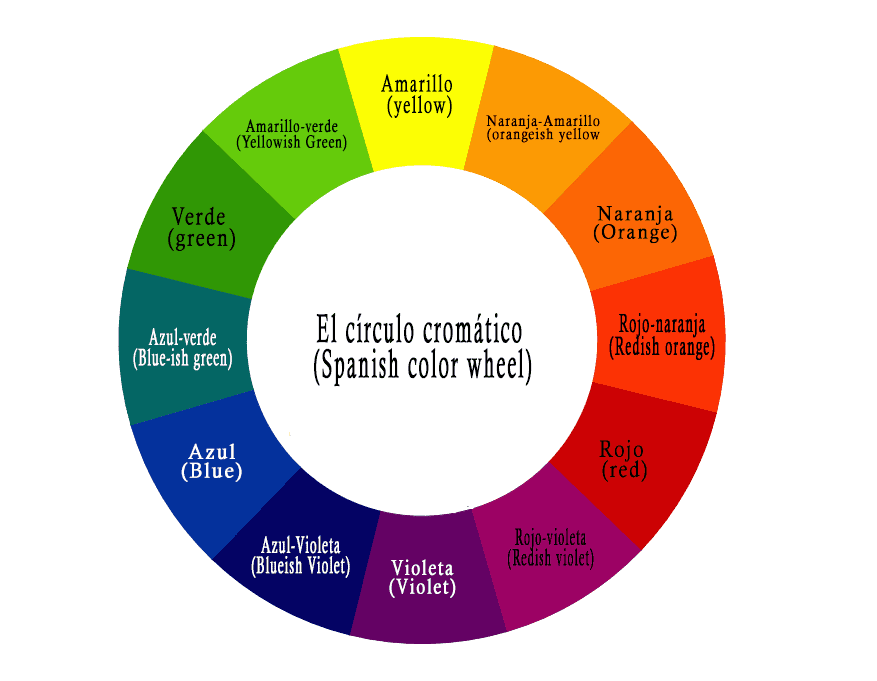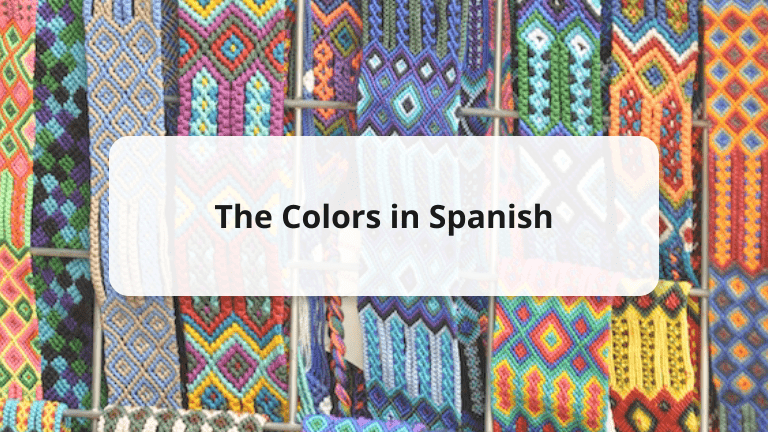Colors are seen and used every day in our lives. Learning how to say the names of colors in Spanish, will help you a lot in terms of building your Spanish vocabulary and overall fluency.
In this article, we will brighten up your world by teaching you how to say colors in Spanish, how to categorize colors, how to describe colors, and how to use colors to describe people!
Also, when you are learning Spanish, starting off either through a Spanish learning app or by learning everyday words such as colors, or colores in Spanish, will really kick off your Spanish learning journey on a fun note! Not to mention, you would have more to say when you encounter real-life conversations in Spanish.
Now, let’s get colorful with Spanish colors.

Table of Contents
The Spanish Colors Wheel (El círculo cromático)

El círculo cromático, or “The color wheel” is an illustration whereby all the colors are organized based on the relationships between each color.
Out of all the colors in existence, here are a total of 12 Spanish colors in the wheel, six colores primarios (primary colors) and six colores secundarios (secondary colors):
| English | Spanish |
|---|---|
| Yellow | Amarillo |
| Orangeish yellow | Naranja-Amarillo |
| Orange | Naranja |
| Redish Orange | Rojo-naranja |
| Red | Rojo |
| Redish Violet | Rojo-violeta |
| Violet | Violeta |
| Blueish Violet | Azul-Violeta |
| Blue | Azul |
| Blueish Green | Azul-verde |
| Green | Verde |
| Yellowish Green | Amarillo-verde |
All colors in the color wheel are also divided into colores cálidos and colores fríos (warm colors and cold colors respectively). The differences in these tones serve as a tool for visual artists to create a certain depth and add a certain emotion to the art piece.
We will now discuss these tones in detail.
Cold Colors in Spanish (Colores fríos)

All the colors in the wheel that are considered colores fríos (cool colors) are:
- Violeta (Violet)
- Azul-Violeta (Blueish Violet)
- Azul (Blue)
- Azul-verde (Blueish Green)
- Verde (Green)
- Amarillo-verde (Yellowish green)
Colores fríos give off the feeling of calmness and coldness (such as ice), but also sadness and indifference. Colores fríos are also used in art to give the illusion that something is further away from the viewer.
Here are 10 other colores fríos and the name of the color in Spanish:
| English | Spanish |
|---|---|
| Lavender | Lavanda |
| Purple | Morado |
| Royal Blue | Azul real |
| Cyan | Cian |
| Forest Green | Verde bosque |
| Mint | Verde minta |
| Emerald | Verde esmeralda |
| Plum | Ciruela |
| Sky Blue | Celeste |
Warm Colors in Spanish (Colores cálidos)

Other Colors in Spanish in Alphabetical Order

It would take hours upon hours to name every color, but here is a list of 50 colors and what they are called in Spanish for some reference:
| English | Spanish |
|---|---|
| Alabaster | Alabastro |
| Aquamarine | Aguamarina |
| Burgandy | Borgoña |
| Citrine | Citrino |
| Drab | Monótono |
| Dove grey | Paloma gris |
| Eggshell | Cáscara de huevo |
| Eucalyptus | Eucalipto |
| Floral white | Blanco flores |
| Fuscous | Fuscus |
| Goldenrod | Vara de oro |
| Hot pink | Rosa caliente |
| Hunter green | Verde cazador |
| Ice blue | Azul hielo |
| Indigo | Índigo |
| Jade | Jade |
| Jonquil | Junquillo |
| Khaki | Caqui |
| Lemon | Limón |
| Laurel green | Verde laurel |
| Midnight Blue | Azul medianoche |
| Mocha | Moca |
| Navy | Armada |
| Oak | Roble |
| Off white | Blanquecino |
| Periwinkle | Bigaro |
| Pink | Rosado |
| Primrose | Primavera |
| Quartz | Cuarzo |
| Quince | Membrillo |
| Raspberry | Frambuesa |
| Raw sienna | Siena natural |
| Royal blue | Azul real |
| Saddle brown | Sillín marrón |
| Scarlet | Escarlata |
| Slate | Pizarra |
| Tan | Bronceado |
| Topaz | Topacio |
| Turquoise | Turquesa |
| Teal | Verde azulado |
| Ultramarine | Ultramarino |
| Umber | Ocre oscuro |
| Viridian | Verde |
| Vermilion | Bermellón |
| Virid | Vírido |
| Walnut | Nuez |
| Xanthic | Xántico |
| Zaffre | Zafre |
| Zomp | Zomp |
Words to Describe Spanish Colors
When you can’t quite remember the name of a color, how do you describe it? Below we have listed out words that you can use to describe colors:
| English | Spanish |
|---|---|
| Transparent | transparente |
| Opaque | opaco |
| Pastel | pastel |
| Bright | brillante |
| Dull | oscuro |
| Fluorescent | fosforescente |
| Light | claro |
| Dark | oscuro |
Use Colors in Spanish to Talk About Body Parts
Imagine you are looking for someone, you ask a stranger if they might have seen said person— they will almost always ask what the person looks like. The names of Spanish colors can come in handy here, we can use colors to describe hair, skin, and eye colors. Even the colors of the clothes the individual wore!
Below is a list of Spanish colors that can be used to describe hair, skin, and eye colors respectively:
Skin Colors in Spanish
| English | Spanish |
|---|---|
| White skin | piel blanca |
| Light brown skin | piel morena clara |
| Brown skin | piel morena |
| Black skin | piel negra |
| Pale skin | piel pálida |
Hair Colors in Spanish
| English | Spanish |
|---|---|
| White | Blanco |
| Ginger | Pelirrojo |
| Blond | Rubio |
| Black | Negro |
| Grey | Gris |
Eyes Colors in Spanish
| English | Spanish |
|---|---|
| Blue | Azules |
| Green | Verdes |
| Hazel | Avellana |
| Brown | Café |
| Amber | Ámbar |
Grammar for the Colors in Spanish
Colors have a lot of uses. They can be used as adjectives to describe a subject or noun, like, la casa rosa (The pink house). As nouns, colors can represent a person or an object, me gusta la amarilla (I like yellow), for example. Lastly, colors can also be used as verbs such as la casa es verde (the house is green) and la niña comió demasiado, ahora su cara está verde (The girl ate too much, now her face is green).
Spanish Colors as Adjectives
Colors are used as adjectives when it describes a noun or a subject. As a rule of thumb, the adjective (the color in this case) will come after the noun, the word order will then be as such:
Adverb + Noun + Adjective (color)
For example; The (adverb) white (adjective) rabbit (noun) in Spanish would be El (adverb) conejo (noun) blanco (adjective).
This is, of course, the just of how to use adjectives in Spanish. Reading up on this topic will give you a better understanding of how adjectives are used in Spanish, as it does have some differences from English.
Example sentences:
El libro verde (The green book)
El gato negro (The black cat)
La chica de ojos azules (The blue-eyed girl)
Una rosa rosa (A pink rose)
El lazo amarillo (The yellow bow)
Spanish Colors as Nouns
Colors are used as nouns when they represent a person or an object. When using colors as nouns, they are always masculine, even when ending with the suffix -a (more about this later). Mostly, the noun gets their name from the color of the subject (An orange (the fruit) is called an orange because the color is… orange. Get it?), these are mostly examples of plants, flowers, or fruits.
Examples of nouns that get their name from their color:
Naranja (orange, an orange fruit)
Esmeralda (Emerald, an emerald-colored gemstone)
Mandarina (Tangerine, a tangerine-colored fruit)
Lavanda (Lavender, a lavender-colored flower)
Canela (Cinnamon, a cinnamon-colored spice)
Example sentences:
Me gusta el color naranja (I like the color orange)
Su vestido era de color esmeralda (Her dress was the color emerald)
Perdió su paraguas mandarina (He lost his tangerine umbrella)
Su cabello estaba teñido de un color lavanda (Her hair was dyed to a lavender color)
Tenia los ojos color canela (He had cinnamon-colored eyes)
Verbs Usage
When using colors as a verb, you use them alongside the verbs verbs ser and estar, which both means “to be”. In brief, ser is used to describe something that will permanently have the color (blue eyes, for example) and estar is used to describe something that is temporary (The dark sky).
This is another topic where things can get confusing, rather read up on Ser vs Estar in Spanish to increase your understanding!
Example sentences:
When using Ser:
El búho es blanco (The owl is white)
Mi libro soy rojo (My book is red)
When using Estar:
La niña se ve pálida de lo asustada que está (The girl looks pale because of how scared she is)
La cosa azul no debería estar ahí (The blue thing should not be there)
Gender Agreement
When using color as an adjective, it must agree in gender and number with the noun the color describes.
Colors that end with the suffix -o (masculine) will most likely change to the feminine form, which is the suffix -a. The exception to this rule would be colors in compound form.
Example sentences:
- Rojo (Red)
- La manzana roja (The red apple)
- El frijol rojo (The red bean)
- Amarillo (Yellow)
- La mesa amarilla (The yellow chair)
- La camiso camarillo (The yellow shirt)
If a color contains another adjective, you don’t have to change it to the gender of the noun.
Example sentences:
- Rojo sangre (Blood red)
- Sus ojos eran de color rojo sangre (His eyes was blood red)
- La luna rojo sangre (The blood red moon)
- Totalmente negro (Pitch black)
- El gata es totalmente negro (The cat is pitch black)
- El cielo es totalmente negro (The sky is pitch black)

Naranja.
Azul.
Violeta.

Give Your World Some Color by Learning Spanish!
With some effort, you would be able to say color names in Spanish at the top of your head!
Learning everyday words, and phrases, and how to describe things with colors is a smart way to quickly get the hang of learning the Spanish language and survive real-life conversations! This is one of many strategies that will aid you in learning Spanish fast. Why stop at Spanish though? Learn how to say colors in Mandarin or colors in Japanese! There is something rather poetic about learning color names in different languages.
If you struggle with Spanish or want to get into learning the language (or any language for that matter), the best course of action is to get a tutor. The best online tutors can be found right on your computer screen at AmazingTalker! With AmazingTalker, you will achieve your language learning goals and hold conversations with natives with ease. All of this and more, at AmazingTalker!
















